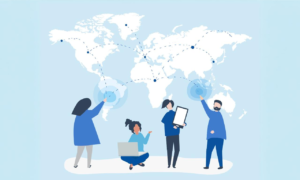Background
Technology has profoundly shaped society over the past few decades, transforming virtually every aspect of daily life. From communication to healthcare, education, and the way businesses operate, technology has been a catalyst for progress. While the effects of technology are often discussed in terms of challenges and concerns, its positive impacts on society are equally significant. This case study explores the positive effects of technology on society, focusing on specific areas such as healthcare, education, communication, and economic development.
Key Areas of Positive Impact
1. Healthcare Advancements
One of the most significant areas where technology has made a positive impact is in healthcare. Innovations in medical technology, from advanced diagnostic tools to robotic surgery, have improved the quality of care, reduced mortality rates, and expanded access to healthcare services.
- Example: Telemedicine and Remote Healthcare Services The rise of telemedicine, especially during the COVID-19 pandemic, has revolutionized healthcare delivery. Telemedicine allows patients to consult with doctors remotely via video calls, reducing the need for in-person visits and making healthcare more accessible, particularly in rural or underserved areas.
- Impact: Telemedicine has improved healthcare accessibility for millions of people, particularly in regions with limited healthcare infrastructure. Patients in remote areas can now receive expert consultations without having to travel long distances, reducing wait times and lowering healthcare costs. It also enables healthcare systems to manage resources more efficiently, improving overall patient care.
2. Education and Learning
Technology has transformed the education sector, enabling more personalized, accessible, and flexible learning experiences. The integration of digital tools, online platforms, and e-learning solutions has made education more inclusive, breaking down barriers to access and improving outcomes for students worldwide.
- Example: Massive Open Online Courses (MOOCs) and E-Learning Platforms Platforms like Coursera, edX, and Khan Academy have democratized education, making high-quality learning accessible to anyone with an internet connection. These platforms offer courses from top universities and institutions in various subjects, allowing learners from all over the world to pursue knowledge and skills at their own pace.
- Impact: MOOCs have opened up educational opportunities to individuals who may not have had access to traditional university education due to financial, geographical, or social constraints. By providing free or low-cost courses, these platforms have empowered millions of people to upskill, reskill, and improve their job prospects, contributing to a more knowledgeable and skilled workforce.
3. Communication and Connectivity
The advent of smartphones, social media, and messaging apps has transformed the way people communicate and connect with each other. Technology has broken down geographical barriers, enabling instant communication across the globe.
- Example: Social Media and Global Connectivity Social media platforms like Facebook, Twitter, Instagram, and LinkedIn have connected billions of people worldwide. These platforms not only allow individuals to stay in touch with friends and family but also enable global networking, knowledge sharing, and activism.
- Impact: Social media has created a global community where people can engage in discussions, share ideas, and collaborate on projects. It has provided a platform for marginalized voices and allowed individuals to raise awareness about important social and political issues. Moreover, businesses have leveraged social media to enhance customer relationships and marketing strategies, contributing to economic growth.
4. Economic Development and Job Creation
Technology has fueled economic development by driving innovation, creating new industries, and fostering entrepreneurship. The rise of the digital economy has given rise to tech startups, e-commerce platforms, and digital services that generate employment and stimulate economic growth.
- Example: The Growth of the E-Commerce Industry E-commerce platforms like Amazon, Alibaba, and eBay have transformed the way people shop and do business. By allowing businesses to sell products online, technology has opened up global markets to entrepreneurs, small businesses, and consumers.
- Impact: E-commerce has created millions of jobs worldwide, from website developers to logistics managers and digital marketers. The sector has contributed significantly to economic growth, with global e-commerce sales expected to surpass $6 trillion in the coming years. By providing entrepreneurs with low barriers to entry, e-commerce has also fostered innovation and competition in the retail sector.
5. Environmental Sustainability
Technology has been instrumental in addressing environmental challenges by enabling sustainable practices and reducing the ecological footprint of human activities. Innovations in renewable energy, energy efficiency, and environmental monitoring are helping mitigate the effects of climate change.
- Example: Solar Energy and Renewable Technologies Advances in solar technology have led to significant reductions in the cost of solar panels, making solar energy more affordable and accessible. Additionally, smart grid technologies are improving the efficiency of energy distribution, while electric vehicles (EVs) are reducing reliance on fossil fuels.
- Impact: The adoption of solar energy and other renewable technologies has contributed to a reduction in greenhouse gas emissions, helping to combat climate change. Governments, businesses, and individuals are increasingly investing in renewable energy sources, which is accelerating the global transition to a low-carbon economy. The widespread use of electric vehicles is also reducing air pollution and dependency on non-renewable resources.
6. Enhancing Creativity and Innovation
Technology has provided individuals with new tools to express themselves creatively and innovate across a wide range of fields. Digital art, music production software, and 3D printing are just a few examples of how technology is enabling creativity and innovation.
- Example: 3D Printing in Manufacturing and Design 3D printing technology has revolutionized the manufacturing process, enabling the rapid prototyping of products and the creation of complex designs that were once impossible or prohibitively expensive to produce. Artists and designers also use 3D printing to create sculptures, jewelry, and other works of art.
- Impact: 3D printing has democratized the manufacturing process, allowing small businesses and individuals to create custom products and designs. In the medical field, 3D printing has enabled the creation of prosthetics and implants tailored to individual patients, improving healthcare outcomes and patient satisfaction. The technology has also reduced waste in manufacturing, contributing to more sustainable production practices.
Challenges and Considerations
While the positive effects of technology on society are evident, it is important to acknowledge the challenges that accompany technological advancements:
- Digital Divide: While technology has brought benefits, not everyone has equal access to it. There remains a significant gap between those with access to digital tools and those without, particularly in developing regions. Addressing this digital divide is essential to ensuring that the positive effects of technology are widely distributed.
- Privacy and Security Concerns: The widespread use of digital technologies has raised concerns about data privacy and cybersecurity. With more personal and business information being stored online, protecting this data from cyber threats has become a top priority.
- Job Displacement: While technology has created new jobs, it has also led to the automation of many traditional roles, particularly in industries like manufacturing and retail. Addressing the displacement of workers through reskilling and upskilling programs is necessary to mitigate the negative effects of automation.
Conclusion
Technology has had a transformative impact on society, improving healthcare, education, communication, economic development, environmental sustainability, and creativity. While challenges such as the digital divide, privacy concerns, and job displacement exist, the overall positive effects of technology are undeniable. By continuing to innovate and address the challenges that come with technological progress, society can harness the full potential of technology to create a more prosperous, connected, and sustainable future.



